Paul Gauguin, Jacques Brel and Herman Melville loom large in the South Pacific
Paul Gauguin inevitably springs to mind on a voyage of discovery to the Marquesas.
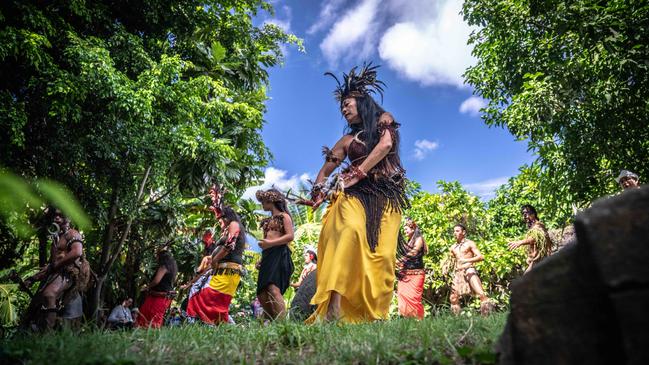
On the Marquesas island of Hiva Oa, two girls stand chatting by a fruit stall. They are striking, with fragrant tiare blooms tucked behind delicate ears and curves enhanced by artfully tied skirts known as pareos, as bright as the fruit beside them. Just this momentary glimpse of island life sets off one of those deja vu moments, a feeling I’ve left the real world and stumbled straight into a painting.
Paul Gauguin inevitably springs to mind. The French artist’s escape to the South Seas is well charted, but it was on this island that he spent his last years, creating arguably his finest works, further detaching himself from civilisation and … well, perhaps I’ll gloss over the more sordid details of his castaway pleasures. Yet, lovely as it is to see his paradise so vividly unchanged, I’ve come to the Marquesas to experience all of the inhabited islands in this remote archipelago. I’m travelling on Aranui 5, a dual cargo and cruise vessel launched in 2015 and continuing a service that has acted as the islands’ lifeline for 40 years. These islands are truly far-flung, beyond the Tuamotus and even further than the intriguing-sounding Disappointment Islands. You need to keep travelling to reach this scatter of islands almost 1500km northeast of Tahiti.
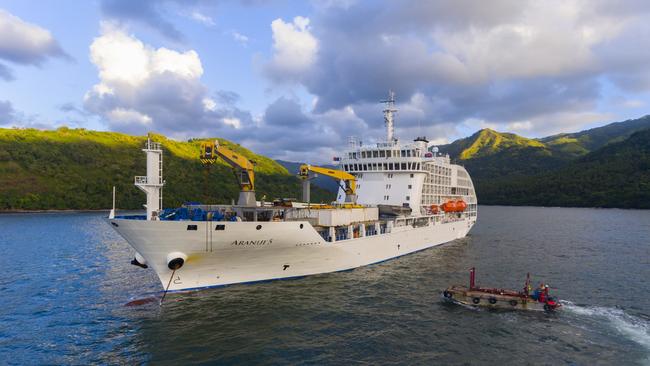
Getting bulky supplies here, other than by sea, is expensive and often difficult. For travellers, unless you’re rich enough to afford a crewed yacht, there is no other way to see all of the Marquesas in one trip. For us, it entails a 36-hour voyage from Tahiti, characterised by the moody Pacific’s buffeting swells at night and gentler sways by day. Aranui 5 (confusingly, the fleet’s fourth ship) is a bizarre-looking vessel that appears to have been cobbled together in a hurry from a Meccano kit. The front is all business and given over to cargo, while the back, visually at odds with the rest of the vessel, comprises an indented, dated-looking pleasure palace of tiered sundecks, bars, a tiny pool and 103 cabins. Perhaps unsurprisingly, life on a part-freighter, even just for a fortnight, provides experiences you wouldn’t have on an ordinary cruise.
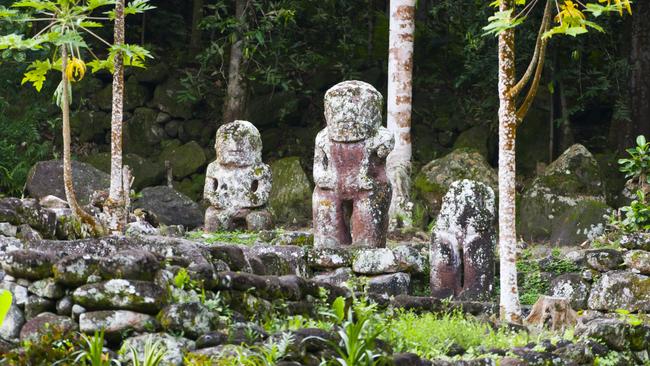
In the early mornings, we drop anchor in natural harbours shouldered by mountains. While other passengers snooze, a few of us watch the dockworkers unload vast containers of frozen food alongside trucks and barrels of fuel. Above the sun-splintered sea, a tractor hovers from a crane. Sometimes, a length of metal piping swings in the breeze and, during one memorable morning, a chestnut stallion is gently lowered on to the deck, destined for a neighbouring island.
Then the exchange begins, with islanders queuing quayside, waiting to offload their commodities, including hessian sacks of copra that will be turned into oil, then crates of mother-of-pearl, fruit and fish. While the workers labour, we gather to disembark. The islands’ names ring in our heads like an incantation for a magic spell: Nuku Hiva, Ua Huka, Ua Pou, Hiva Oa, Fatu Hiva, Tahuata. What links them all, whether tiny or sizeable, is that first glimpse you get from the sea of a dramatic silhouette of basalt cliffs and volcanic spurs, the pleated folds of steep, forested mountains pierced by the silver threads of waterfalls, and agitated waves slapping against black sand.

There are no swanky resorts and it is unusual to come across tourists. Access to Wi-Fi ashore, if indeed possible, requires buying a murky coffee, and sometimes paying a supplement, in a tin-roofed cafe. What you do find, always, is a trail of beautiful garlanded girls handing out sweet-smelling leis or beaded necklaces. To my surprise, the welcome never feels cheesy, but rather expresses a rare and delightful openness of spirit.
Some islands imprint themselves more vividly than others. On Nuku Hiva, the second-largest in French Polynesia, I find a landscape entirely recognisable from passages in Herman Melville’s part-autobiographical novel, Typee — cleft valleys and sharply rising mountains, wild ponies grazing, breadfruit and kapok forests, and banana groves set between splashes of scarlet bougainvillea. We are travelling in 4WDs rather than swinging down gorges from sappy branches, as was Melville’s precarious approach to the Taipivai Valley, but the impact is just as powerful, with the lush plains largely unmarred by development.
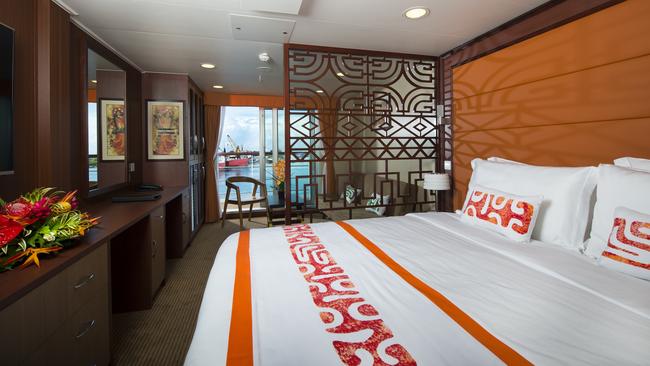
Undeveloped, too, are the islands’ archeological treasures. At Puamau, on Hiva Oa, stone tiki statues stand in a forest clearing like squat, ghostly figures. On Nuku Hiva, ancient banyans spread a tangle of roots as complicated as ship’s rigging around Tohua Kamuihei, a setting vividly brought to life by Melville in Typee. With sacrificial platforms, large me’ae (ritual sites), meeting places fashioned from basalt boulders and petroglyphs of turtles, outrigger canoes and fish, these places provide a fascinating insight into Marquesan rituals and date from an era long before any missionaries arrived.
The sights are many and powerful as the days roll by: flying fish leaping through the silver sea; the dun-coloured outline of five manta rays floating in a harbour; crew members dangling fishing lines from our ship’s bow.

Equally lovely is the normality of the islanders’ flower-studded headdresses and welcoming smiles and, on tiny Tahuata, while children cluster on rocks before plopping into the sea with the grace of tiny seals, the sight of a villager taking his large sow for a beachside stroll.
Over evening drinks, while a crimson sunset flares the sky, cruisers gather in the ship’s veranda bar to trade experiences. For some, it’s the sweaty 18km hike across the steep spine of Fatu Hiva, one of the most remote of all the Marquesas. For others, it is witnessing the snorts, grunts and javelin jabs of festooned islanders performing traditional dances. For me, it has to be the bursts of colour on Ua Huka, an idyllic little island where purple and green lorikeets screech amid the palms. Its beautiful botanic garden is filled with deliciously sweet mangoes, custard apples, pomegranates and soursop, all of which islanders and visitors are encouraged to pluck and eat.
Evenings are the best time on board, whiled away in that veranda bar, with its cosy rattan armchairs, but mealtimes are my least favourite moments. The queue-shoving and table-grabbing (tables are for six, with only one sitting and a no-choice set meal heavy on roast meats) become, at times, too much to bear, particularly when compared with the civilised generosity we encounter on the islands.
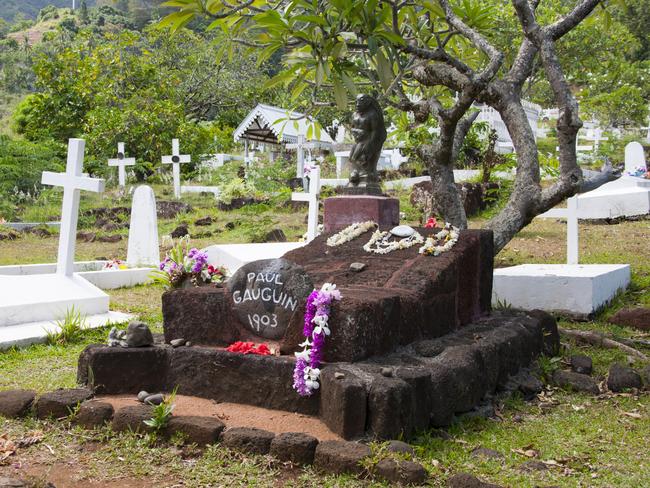
Often, I am happy simply to retreat to my cabin in the bowels of the ship, which, in rough waters feels much like being locked in a laundrette, waves sloshing through a fast spin cycle against my tiny porthole.
Yet there are compensations such as the small but well-stocked library of relevant books, fantastic staff, the occasional al fresco buffet where we eat the Marquesan delicacy of raw tuna mixed with lime and coconut milk, pareo-tying classes and Polynesian dance instruction. There are lectures and films about Polynesian history. On one evening, we watch a documentary about the singer-songwriter and actor Jacques Brel, who sailed to Hiva Oa in 1975 and became the islanders’ most respected long-term visitor. While ashore on that island, after a heart-skipping hike along coiled, vertiginous roads, we visit Brel’s grave and that of Gauguin in the Calvary cemetery, above the village of Atuona. The tributes, particularly to Brel, are many; so, too, the flimsy tiare blooms shed by the overhanging trees.
Above our heads, storm petrels chase the thermals over sea-thrashed rocks. Beneath us, the fretted coastline fronts a barely changed world of thatched homes, wood smoke, ponies grazing in a field. It paints a picture of a land at peace with itself, surely a rare and enviable commodity.
Louise Roddon was a guest of Aranui 5.
THE TIMES
-
IN THE KNOW
Aranui 5 operates 13-day round-trip cruises to the Marquesas ex Papeete, departing Saturdays or Thursdays; accommodation in suites with balconies is available as well as standard cabins. A Pitcairn Discovery Cruise to the Tuamotu, Gambier, Pitcairn and Austral islands departs April 11. Ultimate Cruising has packages available from $9699 a person twin-share (Marquesas) or $11,389 (Pitcairn); add airfares.

To join the conversation, please log in. Don't have an account? Register
Join the conversation, you are commenting as Logout